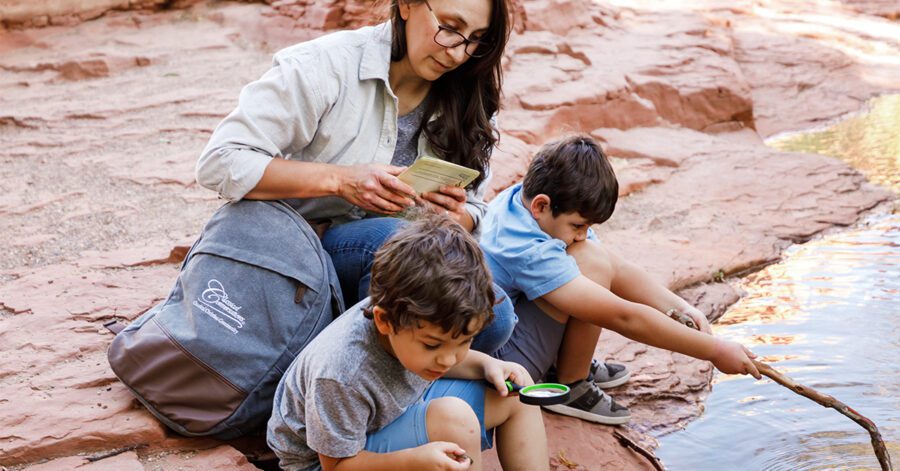Revisiting Some Archived Articles that Have Not Been Lost, but May Have Been Forgotten and Are Worth a Fresh Read
Original Post Date: August 26, 2011
Sometimes the term “science” seems overwhelming. We picture people in white lab coats, equipment that costs tens or hundreds of thousands of dollars that require expert handling, equations that no one understands, and people speaking gibberish to one another. While this is sometimes the case, in most cases science is done under simpler conditions, with simpler experiments.
There is one field of study, however, which is literally hardwired into every person alive — taxonomy. Taxonomy is the study, ordering, and naming of the living world. Taxonomy is a special gift and duty that comes straight from God. After creating life, one of the first tasks that God called Adam to do was to name the animals that God had created (Genesis 2:19-20). Since that time, every culture has been engaged in naming and ordering living things they encounter.
It appears that there may actually be a part of your brain in the temporal lobe that assists in taxonomy. Imagine that! Not only did God create the world and everything in it, God designed you so that you can recognize and understand it! However, this does not mean that our every intuition about the natural world will be right. Just like the other senses God gave us, they must be practiced, honed, and even then will still sometimes be wrong. But nonetheless, taxonomy is an ability that is wired into each one of us to connect us to the world God made.
Simple Steps to Get Started in Taxonomy
To get started in taxonomy, you do not need a book, or a website, any special tools, or any special knowledge. In fact, I would encourage you to do taxonomy first, and then look at the books. Basically, taxonomy requires that you look closely at living things, make careful observations about them, and then group them according to similarities and differences. Some observations you can make about living things are:
Counting – how many leaves? Flower petals? Feet? Antennae? Body segments? Leaf segments? Find anything countable, and count them!
Shape – what are the basic forms that are being expressed? Draw what you are looking at as a stick figure. Draw it as a series of shapes (squares, triangles, circles, etc). Try to understand the overall pattern of what you are looking at.
Development and Reproduction – what does it look like when it is young? How does it grow? What does it do when it matures? What are its life stages? For plants, what kind of flowering structures does it make, and what kind of seeds are produced?
Interesting Features – what are the interesting features that stick out to you? How do these features relate to other living things?
Keep a sketch book and a journal. If you don’t know the names of the animals, give the animals your own names. You can look up their scientific classification later. To start with, just go out and see nature for yourself. You were created to do it!
Listening to God in Nature
Throughout history, nature has been a source of knowledge about God. Scripture confirms this use of nature – “For since the creation of the world God’s invisible qualities—his eternal power and divine nature—have been clearly seen, being understood from what has been made, so that men are without excuse” (Romans 1:20). As George Washington Carver put it, “I love to think of nature as unlimited broadcasting stations, through which God speaks to us every day, every hour and every moment of our lives, if we will only tune in and remain so.” (Carver, “How to Search for Truth”)
What does God tell us in nature? I think there is something about looking closely at nature that changes us that is beyond mere intellectual curiosity and knowledge. Living in a city, constantly looking at human architecture and artifacts, we start to think in the ways of the world. Going out into nature and looking at God’s architecture and artifacts gives us a deeper understanding of God’s way of looking at the world.
For those who need a more practical reason, looking at nature is about seeing the natural order, and, most importantly, seeing there is an order. Just seeing an order and knowing that it is there helps us to realize there is a larger plan of which we are a part.
From the intricacy of every living thing, we can understand God’s impressive wisdom and power. Looking at insects under a microscope demonstrates that God took care in designing even the smallest of creatures. From the hierarchical pattern of taxonomy, we can see there is an order to which everything belongs. Walter ReMine, in his book, The Biotic Message, notes that hierarchical patterns have the advantage that the pattern can still be perceived even if parts are missing. Thus, we can see that God’s design is such that it can withstand the accidents of history. Even if you don’t have access to all the creatures God has made, you can still see His pattern.
We can also see in nature the interdependence of everything. In this we can see that it is the creation of a single planner because organisms from every kingdom are built to work together to create ecosystems. In nature we can see what God puts together when He paints a picture. By examining everything closely, we can see the beauty, proportion, and form that is put in every living thing. We can see the variations, and we can see the patterns.
Advanced Taxonomy
As you get more advanced in taxonomy, you can start asking interesting questions. For instance, once you realize the immense variety even within a species, it is reasonable to ask how much variation God put in the different created kinds. This study actually has its own field known as baraminology, from the Hebrew words which mean “created kind.”
Another source of questions are about “body plans.” Vertebrates (animals with backbones), for instance, all share a basic body plan – bony bodies with a spine, a skull, and appendages (i.e. arms, legs, fins, or wings). This body plan is consistent among fish, amphibians, reptiles, mammals, and humans. However, the arthropods (spiders, insects, etc.) represent a radically different way of putting animals together, but still have the same general set of appendages (body, legs, head, etc.). Thus we can see two very different implementations of the same pattern which exist together throughout the world as if God is giving us two different ways of looking at how to put an organism together and asking us to see the different ways He designs.
Finally, when we start understanding how all the organisms work, and work together, we can put our knowledge into understanding ecology, which is the way in which God’s creatures work in a community. Understanding this community will help us fulfill our place as the stewards of His creation.




